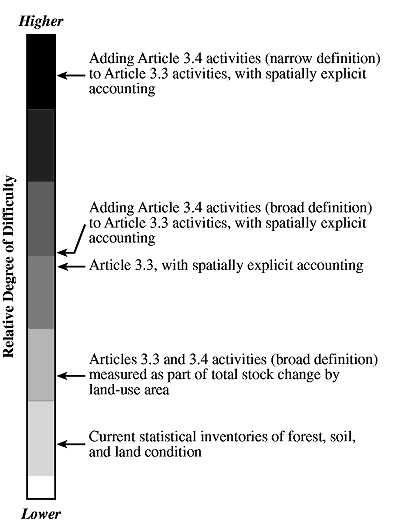|
4.3.3. Land-Based versus Practice-Based Accounting
The choice of accounting approaches will be important in establishing the difficulty
in implementing additional activities under Article 3.4 (see Section
2.3.2.2 for a discussion of these accounting issues and Section
3.3.2 for a discussion of various measurement methods as they apply to Article
3.3 activities). If the Parties decide on land-based measurement for activities
under Articles 3.3 and 3.4 and the affected Parties are successful in identifying
and tracking individual land parcels in a land-based system, some additional
cost and difficulty would result from the extra parcels of land that would need
to be tracked, measured, and recorded as a result of additional Article 3.4
activities. This increased cost and difficulty may not pose a significant challenge
if a Party's reporting is based solely on project activities. If the Party wishes
to report on the implications of a policy or program with national impacts,
however, the technical and operational difficulties may become significant.
The additional demand for field monitoring resources would essentially scale
linearly with the number of separate land areas involved. The incremental effort
may be small, however, relative to the large investment of effort needed for
the initial establishment of a system for Article 3.3, unless the sheer number
of land areas overwhelms the system's capability.
If a land-based approach were chosen, the demand on a Party's measurement and
accounting system created by the additional activities selected under Article
3.4 would be significantly affected by the manner in which those activities
were defined. Under the broad definition, the monitored land areas might be
large regions of similar land use where periodic measurements based on statistical
sampling methods were used to document changes in stock over the whole area.
If the narrow definition of activities is utilized-and a fairly lengthy list
adopted-maintaining a spatially explicit database on each land area where activities
were implemented may be beyond the capacity of any existing national environmental
inventory system, so the Parties may wish to consider options that do not require
spatially explicit recordkeeping. In selecting among these options, the major
issues are likely to be cost and feasibility (Figure 4-7).
Although all options are technically feasible, they vary widely in their degree
of difficulty. Where Parties have strong institutions of private land ownership
and management responsibility, establishing a system in which land owners and
managers carry out the basic measurements and annual monitoring, with verification
by a third party or government, may be feasible. (The issues of accounting methods
discussed in Chapters 2 and 3 would
be encountered in a similar manner with activities under Article 3.4.)

|
|
Figure 4-7: Relative costs of measuring and
reporting carbon stock changes under different decisions regarding definition
of "activities" and requirements for spatially explicit accounting.
|
The impact of these policy choices on monitoring and reporting effort may or
may not be significantly affected by selection of a short rather than long list
of activities under Option A, if a broad activity definition is adopted. In
instances in which a national inventory system is established and the entire
land surface is periodically monitored, the addition of further activities would
represent no additional effort. If a narrow definition of activity were adopted,
the effort would essentially scale up with the number of land areas affected
by that activity, and by the number of different activities in the list. The
effort would continue to rise, even once the entire land surface of an area
was under observation.
One effect of selecting Option B associated with a flexible approach to definitions
would be to encourage research and development of new and more efficient methods
of measurement, monitoring, and verification. The Parties might choose to make
an initial decision that allows for a broad approach during a testing period,
with a second review period to take place at a specified future date, as a means
of encouraging innovation while protecting against the permanent establishment
of methods that might later be regarded as inappropriate.
|